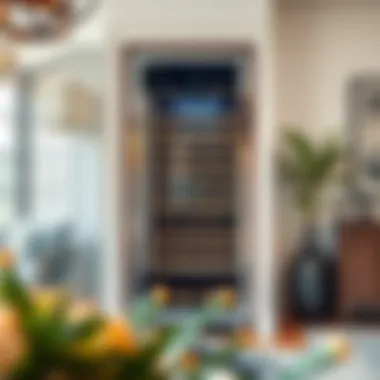Understanding Wine Coolers with Cabinets: A Full Guide


Intro
In recent years, wine coolers with cabinets have gained significant traction among homeowners, interior designers, and wine aficionados alike. These appliances serve a dual purpose; they preserve your treasured bottles while harmoniously blending into your home’s decor. For a modern individual who appreciates both aesthetics and functionality, integrating a wine cooler with a cabinet can elevate a living space to a whole new level.
This guide aims to provide a thorough overview of what to consider when exploring the diverse range of wine coolers with cabinets. From design inspiration to maintenance techniques, every detail matters in making a decision that complements both your stylistic preferences and your domestic needs. Whether you’re setting up a dedicated wine area or simply looking to enhance your kitchen or dining space, understanding the nuances of these coolers is essential.
By analyzing the latest market trends and technological advances, readers will be better equipped to make informed choices when incorporating wine coolers into their homes. Various design contexts will be discussed to highlight the manifold ways one can showcase wine collections while ensuring that they remain at optimal temperatures.
As we delve into this exploration, it will become clear that wine coolers do not merely serve a utilitarian need; they embody a lifestyle choice that speaks to personal taste and social escapades. Let’s embark on this journey of discovery to unveil how wine coolers with cabinets can transform not just your collection, but the entire ambiance of your space.
Prelims to Wine Coolers with Cabinets
In recent years, the popularity of wine coolers with cabinets has surged among homeowners and enthusiasts alike. The love for wine isn't just about the taste; it's about the experience and how you can showcase your collection. This section serves as an essential overview of the topic, illuminating not just the functionality of these units but also the aesthetic and organizational benefits they bring to any living space.
Wine coolers with cabinets combine practical refrigeration with stylish cabinetry, making them not only storage solutions but also integral components of modern interior design. These units can seamlessly incorporate into kitchens, dining rooms, or home bars, providing a dedicated space for your bottles.
Understanding the Basics
At its core, a wine cooler with a cabinet is designed to allow wine to be stored at optimal temperatures, which ensures that the delicate flavors and aromas are preserved. The basic features often include adjustable racks, temperature control settings, and sometimes dual-zone functionality that caters to both red and white wines. Beyond the essentials of temperature, these coolers provide a sense of luxury, presenting your wine in an elegant manner that spurs conversations.
A well-placed wine cooler not only serves its primary purpose but also reflects the owner's taste and personality. The right design can turn a simple appliance into a striking focal point. Whether you're a casual drinker or a serious connoisseur, understanding these nuances can significantly enhance your wine enjoyment experience.
Historical Context of Wine Storage Solutions
Historically, wine storage has evolved dramatically. In ancient times, large clay vessels were used to keep wine cool, often buried in the ground or tucked away in shaded areas. As winemaking advanced, so did the need for better storage solutions. The advent of glass bottles in the 17th century transformed how wine was stored, leading to the introduction of cellars as essential features of grand homes.
Fast forward to the modern day, wine coolers with cabinets represent the latest evolution in wine storage technology. Today, consumers are not just looking for space; they desire a product that aligns with their lifestyle and aesthetic sensibilities. The contemporary wine cooler with a cabinet offers an intersection between tradition and innovation, encapsulating both the history of wine storage and the modern-day quest for convenience and style.
These coolers have grown more sophisticated over time, with features that cater to the knowledgeable enthusiast while remaining accessible for novices. This blend of practicality and design consideration has made wine coolers with cabinets a staple in many homes, merging utility with the appreciation of fine beverages.
Types of Wine Coolers with Cabinets
Understanding the various types of wine coolers with cabinets is crucial for anyone looking to add functionality and flair to their wine storage solutions. These coolers not only provide a designated space for your wine collection but also play a significant role in maintaining the quality of your wines. Exploring these varieties reveals the distinct features, advantages, and considerations that can influence your selection process.
Freestanding Wine Coolers
Freestanding wine coolers are like the versatile Swiss army knives of wine storage. They can be placed anywhere with adequate space, making them an ideal choice for those who value flexibility. Typically, these coolers offer greater capacity and can come in various styles and designs to fit different decors.
One notable benefit is how easy they are to install; just plug them in, and they're ready to go. This makes them perfect for those who might not want to engage in complex installations or renovations. However, potential buyers should keep in mind that these units may require extra space around them for ventilation.
Additionally, freestanding coolers often come in multiple price points, appealing to both the budget-conscious and those looking to splurge on high-end models. Their designs can range from sleek, modern appearances to more traditional wooden finishes, allowing you to choose one that fits your home aesthetic.
Built-in Wine Coolers
If you’re aiming for a more seamless and streamlined look in your home, built-in wine coolers are the way to go. These units are designed to fit snugly under counters or in cabinetry, integrating into kitchen or dining room aesthetics beautifully. Their sleek construction allows for a custom fit, which can enhance the overall appearance of the space.
For those who entertain frequently or have a built-in bar area, these coolers can serve as sophisticated focal points without crowding the area. Another key advantage of built-in coolers is their temperature consistency. Due to their insulated design, they tend to maintain an optimal temperature, ensuring the wine is always ready to serve.
That said, potential buyers should measure their spaces carefully before installation. Also, built-in models usually come with higher price tags, but many consider it a worthy investment for long-term aesthetics and functionality.
Dual-Zone Wine Coolers
For the discerning wine lover, dual-zone wine coolers are like striking gold in the wine storage world. These specialized coolers boast two distinct temperature zones, allowing you to store different types of wines at their ideal temperatures.
This functionality is especially beneficial for those who enjoy both red and white wines, as each type requires a specific temperature range for optimal flavor and aroma. Imagine opening a bottle of crisp Chardonnay that's been kept at the perfect chilly temperature, ready to impress your guests.
Moreover, these coolers often come equipped with advanced features such as digital temperature control and humidity regulation. Such technology can really elevate a wine cellar experience at home. However, with their sophisticated engineering often comes a higher price point, so weighing your budget against your needs is essential.
"When it comes to wine storage, investing in quality equipment protects not just your collection but also your enjoyment of it."
Choosing the right type of wine cooler with a cabinet is integral to enhancing how you store, present, and enjoy your wines. Whether you're leaning toward the mobility of freestanding units, the sleek integration of built-ins, or the specialized functionality of dual-zone coolers, understanding these types will greatly aid you in making an informed decision.
Design Considerations
When selecting a wine cooler with cabinets, the design factors are just as crucial as the functionality of the appliance. A well-thought-out design not only enhances the appearance of your space but also influences how effectively the cooler serves its purpose—preserving your precious wines. Here we will delve into significant elements such as material choices, size considerations, and aesthetic appeal, which all contribute to creating a harmonious atmosphere in your home.


Material Choices for Cabinets
Material selection is fundamental as it often dictates the durability, maintenance, and overall look of your wine cooler. Let's break down some prominent choices:
Wood Variants
Wood provides a classic touch to any wine cooler. It can be particularly attractive for homeowners who appreciate the warmth and authenticity it brings to the décor. Solid woods like oak or walnut are popular because they are sturdy and age beautifully over time. One reason wood remains a favored choice is its natural insulation properties, which can help in maintaining the right temperature for wine storage.
However, wood comes with its vulnerabilities, particularly its susceptibility to moisture and heat fluctuations. Thus, choosing quality finishes and ensuring proper placement away from heat sources is crucial. For many, the beauty of wooden cabinets outweighs these drawbacks, making it a timeless selection.
Metal Finishes
For those who lean towards a more modern aesthetic, metal finishes can be quite appealing. Stainless steel and aluminum not only offer a sleek and contemporary look but also provide excellent durability and resistance to wear. The key characteristic of metal finishes is their ability to complement various styles, from industrial to minimalist.
While they are easier to clean and maintain than wood, metal surfaces can be prone to fingerprints and smudges, often requiring more frequent wiping. Still, many homeowners appreciate the chic vibe they bring to a kitchen or living space, distinctly elevating the overall design.
Glass Elements
Incorporating glass into the design of wine coolers can bring a touch of elegance. Glass elements allow for the display of wine collections, enticing guests and sparking conversations. Tempered glass doors are a popular option, as they strike a balance between showcasing your collection and providing adequate insulation.
However, glass is not without its challenges. While it enhances visibility, it can also expose wines to light, which may not be ideal for long storage periods. Mitigating this concern often involves additional UV protection. Despite these minor drawbacks, glass remains a sought-after option for its ability to accentuate the beauty of wine bottles.
Size and Dimensions
Choosing the right size for your wine cooler is important, considering space availability and wine collection size. Wine coolers have evolved to cater to various needs.
Compact Models
Compact models are a fantastic space-saving solution, especially for those living in smaller homes or apartments. They can easily fit under counters or in tight nooks, making them suitable for almost any setting. One of the primary advantages is their affordability, which appeals to budget-conscious wine enthusiasts.
The downside, however, is the limited storage capacity. Such units are typically best for someone with a modest collection or those who prefer rotating their wines frequently. If your wine collection expands, you may soon find yourself in need of more storage space.
Full-Size Units
On the other end of the spectrum, full-size units can accommodate larger collections and provide more than just storage; they often come with advanced cooling technology and additional features like dual zones for red and white wines. This size is beneficial for avid collectors or householders who enjoy entertaining guests with an extensive selection of wine.
The main drawback is the floor space required. These units can be more of a financial investment and may limit placement options due to their bulk. However, for a wine lover, the long-term benefits of having ample space to house and display a wine collection often outweigh the initial costs.
Color Schemes and Aesthetics
The aesthetic of your wine cooler is paramount in ensuring it complements your home’s overall design. Color schemes go a long way in creating a visual balance with your furnishings and styles.
Opting for neutral colors can provide versatility, allowing the wine cooler to blend seamlessly with various design elements. If you desire a bolder statement, choosing rich, dark shades or vibrant colors can draw attention, making the cooler a focal point in the room.
A cohesive aesthetic throughout your home can unify different spaces while highlighting your taste and passion for fine wine. Balancing color schemes and materials employed in wine cooler design will create an inviting and tasteful atmosphere for both everyday use and special occasions.
Functional Benefits
When it comes to storing wine, a cooler with a cabinet isn't just a luxury; it's a functional solution that caters to the varied needs of every wine aficionado. Understanding the benefits associated with these wine coolers enhances your ability to make informed decisions. Here, we'll explore three critical functional benefits: optimal temperature control, humidity regulation, and space efficiency.
Optimal Temperature Control
Wine is a delicate beverage that requires specific temperature settings to maintain its integrity. Wine coolers with cabinets are designed to provide precise temperature control, which is crucial for preserving the taste and quality of your wines. For instance, red wines typically thrive at a range of 55°F to 65°F, while white wines prefer cooler temperatures, around 45°F to 55°F. With features such as digital thermostats and adjustable zones, these coolers allow users to set and monitor the temperature easily, ensuring that each bottle remains in its ideal environment.
"Temperature is everything for wine; get it wrong, and you might as well be drinking grape juice."
When considering a wine cooler, opt for models that feature double or even triple-layered glass doors. This insulation not only conserves energy but also fortifies against external temperature fluctuations, making your cooling environment stable and reliable year-round.
Humidity Regulation
Equally as vital as temperature is humidity. Most wines flourish in a humidity range of 50% to 70%. If the humidity dips too low, corks can dry out, allowing air to spoil your precious collection. Conversely, high humidity can lead to mold growth and label damage. Wine coolers with cabinets often include built-in humidifiers or features to enhance natural humidity retention. Many high-end models utilize hygrometers to give you a constant read on humidity levels.
Additionally, consider investing in a cooler that circulates air within the cabinet. This ventilation helps to create a stable environment, minimizing fluctuations that could lead to spoilage. The preservation of wine isn’t just about taste; it’s also about preserving the history captured in each bottle.
Space Efficiency
In today's homes, space can often be at a premium, and this is where wine coolers with cabinets truly shine. Many models are created with both form and function in mind, balancing aesthetic appeal with practical storage solutions. For smaller apartments or homes, compact wine coolers provide an excellent way to store wines without taking up an entire room.


In addition, some coolers come equipped with adjustable shelves, allowing flexibility in accommodating different bottle sizes—from standard Bordeaux to larger format bottles.
When integrating one into your home, it’s important to consider location. Whether you place it in the kitchen, dining area, or even a dedicated wine cellar, a strategically positioned wine cooler can serve as both a centerpiece and a conversation starter.
Overall, understanding the functional benefits of wine coolers with cabinets will help elevate your wine storage experience. It's not just about having a place for your bottles; it's about creating the right environment to enhance their flavors and longevity.
Choosing the Right Wine Cooler with Cabinet
Selecting the right wine cooler with a cabinet is more than just a matter of aesthetics; it’s about creating an ideal environment for your wine collection. Each bottle has its own unique characteristics, and understanding those is key when it comes to choosing. A proper cooler not only enhances the presentation but also maintains optimal conditions for your wines—be it temperature, humidity, or light exposure.
Assessing Your Wine Collection
Types of Wines
One must first consider the types of wines you plan to store. Red, white, or sparkling varieties all have different storage needs. For instance, reds often benefit from slightly higher temperatures than whites, which should be chilled. Additionally, sparkling wines may require specific humidity levels to keep the cork in good shape. Each wine type brings its own storage challenges and advantages, making it essential to choose a cooler that accommodates those needs. More than just practicality, this careful consideration adds a layer of sophistication to wine collection management.
Quantity Considerations
Another critical aspect involves quantity considerations. How many bottles do you own or plan to acquire? Many wine coolers come with specific capacities designed for varying collections. A smaller unit might work if you're only storing a select few, while larger collections may warrant a full-size or dual-zone cooler. This capacity not only simplifies access but also prevents overcrowding, which can lead to fluctuating temperatures and humidity levels. The right size ensures that every bottle has its designated space and receives proper care.
Budgeting for Quality
Price Ranges
When it comes to wine coolers, price ranges can be a guiding factor in your selection process. Prices vary greatly depending on size, features, and brand reputation. A basic model may be accessible at a lower cost, but investing a little more can yield substantial benefits. High-end models often come equipped with advanced features like dual-zone cooling, energy efficiency, and better build quality. Thus, setting a well-thought-out budget beforehand can help narrow down options while also ensuring you get a cooler that fits your needs—not just your wallet.
Long-Term Value
Finally, consider the long-term value rather than just the initial price tag. A more expensive cooler might seem daunting upfront, but if it lasts longer and protects your investments better, it can save you from future headaches. Understanding the durability, warranty options, and user reviews plays a key role in evaluating long-term value. A cheaper unit may lead to rapid failures or poor temperature control, negating any initial savings. So, before you make that leap, weigh the potential return on investment carefully.
Brand Reputation and Reviews
Don’t skip out on brand reputation and reviews. In today’s digital age, it’s easier than ever to check testimonials and complaints about specific models. Look for manufacturers that have a proven history of quality, service, and customer care. User reviews can provide insights into how well a cooler operates under real-world conditions. Remember, choosing a wine cooler is not just a one-time decision; it’s an investment in your collection and lifestyle. The right cooler should complement your home design, enhance your wine enjoyment, and most importantly, keep that priceless collection in tip-top shape.
Quality is remembered long after the price is forgotten.
With these considerations, homeowners and wine enthusiasts alike can feel more equipped to choose the best wine cooler with a cabinet. Having the right combination of type, size, budget, and brand reputation ensures that your wine remains at its best—because every great vintage deserves a home that reflects its worth.
Maintenance and Care
Maintaining a wine cooler with a cabinet is essential for preserving the quality of your wine collection. It’s not just about enjoying fine wines; proper maintenance ensures that you’re protecting your investment. The careful handling of these units maximizes their longevity and efficiency, allowing your wine to taste as intended. Ignoring the basic maintenance practices can lead to temperature swings and poor humidity levels, which may alter the flavors and aromatic profiles of your beloved bottles.
Regular Cleaning Practices
Cleaning a wine cooler may seem tedious, but it’s vital for ensuring a consistently excellent environment. Dust and grime can accumulate in and around the unit, affecting both airflow and performance. Here are some steps to keep in mind:
- Unplug the Unit: Safety first! Always unplug it before starting.
- Use Mild Detergents: A soft cloth and a mixture of warm water with mild dish soap works wonders. Avoid harsh chemicals that may leave residue.
- Clean the Shelves: Detach and clean shelves separately, ensuring that any spills or detritus are dealt with promptly.
- Wipe Down the Exterior: Regularly cleaning the exterior of your cooler maintains its aesthetic appeal.
- Check Filters: If your unit has a filter, clean or replace it as per the manufacturer’s instructions.
Achieving this simple routine can prolong the life of your wine cooler and improve the air circulation within.
Temperature Checks and Calibration
Proper temperature control is of the essence when dealing with wine storage. Wines are sensitive to temperature fluctuations. If it’s too hot, your wines may age prematurely; if too cold, flavors might be dampened. It’s advisable to check the temperature regularly with a reliable thermometer placed inside the cooler. Ideally, the temperature should hover between 45°F and 65°F for optimal storage.
Additionally, calibrating the thermostat is critical. If you notice irregularities, refer to the user manual for recalibration steps.
- Digital vs. Analog: Digital displays can be more precise and easier to read, but analog can still do the job if properly used.
- Frequent Monitoring: Depending on the climate you live in, make it a habit to check the temperature at least once every few weeks.
Keeping a close eye can prevent unwanted situations where a bottle might spoil unexpectedly.
Addressing Common Issues
Every wine cooler might face a few issues now and then, whether it's noise, temperature imbalance, or issues with humidity. Here’s how to address some of these typical concerns:
- No Noise Issue: If the wine cooler isn’t making any noise, the compressor might not be functioning. First, check if it’s plugged in. If it is, investigate for any blown fuses.
- Temperature Fluctuations: If the cooler struggles to maintain a consistent temperature, it might be due to door seals not closing properly. Inspect the gaskets for any cracks or debris.
- Humidity Issues: Ideally, a wine cooler should have humidity levels between 50% and 70%. If it’s too low, consider placing a small bowl of water inside to increase moisture.


Advisably, be familiar with your unit’s warranty and customer service options. Knowing when it’s best to consult a tech or utilize warranty services can save you a lot of trouble.
Regular upkeep not only enhances the functionality of your wine cooler but also ensures your collection remains in its optimal state.
By adhering to these maintenance and care guidelines, you’ll not only ensure your wine cooler operates smoothly but also enhance the long-term enjoyment of your wine collection.
Integration into Home Design
In today's world of interior design, integrating functional appliances like wine coolers with cabinets is paramount. Not only do they provide practical benefits in keeping wines at the ideal temperature, but they also contribute to the overall aesthetic of a living space. Understanding how to effectively incorporate these wine coolers into home design is crucial for creating a harmonious environment.
Wine Coolers as Centerpieces
When considering wine coolers with cabinets in home design, they often serve as striking centerpieces in a room. Their design, functionality, and position within a space can draw the eye, enhancing a room's appeal.
- Style Statement: A well-selected wine cooler not only stores wine but becomes a visual highlight. For instance, a sleek, stainless-steel cooler can add a modern touch to a contemporary kitchen, while a classic mahogany cabinet may complement a traditional dining area.
- Function Meets Fashion: Positioning a wine cooler near social areas like living rooms or dining rooms provides immediate access for guests and enhances interaction. It's not just about where you store your bottles; it’s about how it fits into your daily life.
"Making a wine cooler a visual attraction turns storage into a dialogue piece, where form meets function seamlessly."
Cohesion with Other Furniture
The placement and design of wine coolers with cabinets must synchronize with other furniture within the space. Cohesion creates a fluid and inviting atmosphere, making rooms feel thoughtfully designed rather than pieced together.
- Harmonious Relationships: Choose a wine cooler that echoes color schemes or materials found in surrounding furnishings. If your dining table is a rich walnut, a cabinet with similar wood tones will establish a visual connection.
- Balance and Spacing: It’s vital to maintain proper spacing between food prep areas, dining tables, and wine storage. A cramped layout can hinder movement and make the room feel chaotic. Instead, give enough room around the cooler for effortless access without disrupting the flow of the design.
- Complementary Decor: Decorative elements surrounding the wine cooler—pictures, plants, or even lighting—should complement rather than contrast. Use items that create a consistent theme, whether it's rustic, modern, or eclectic, ensuring the wine cooler enhances the overall decor.
In essence, successfully integrating wine coolers with cabinets into home design is about striking a balance between utility and aesthetics. By thoughtfully choosing styles that serve as centerpieces and ensuring cohesion with other furniture, homeowners can elevate their spaces, making them functional yet attractive.
Market Trends in Wine Coolers
In a world where wine appreciation is on the rise, understanding the market trends in wine coolers with cabinets becomes more pertinent than ever. As the demand for efficient wine storage solutions grows, so does the innovation in technology and sustainability practices within the industry. Homeowners and designers alike need to keep an eye on these trends to make informed choices that align with both their aesthetic preferences and functional requirements.
Advancements in Technology
The evolution of technology in wine coolers cannot be overstated. Today’s models boast sophisticated features that enhance user experience and wine preservation. Smart technology is at the forefront of these advancements, with many coolers now equipped with Wi-Fi connectivity. This enables users to monitor their wine's condition from anywhere via mobile applications. Imagine being at a dinner party and wanting to check the temperature of your prized Cabernet without leaving your guests – that is the convenience smart wine coolers provide.
These technologically advanced coolers also feature improved cooling systems. Unlike traditional compressors that can create temperature fluctuations, modern coolers often utilize thermo-electric systems. These offer a quieter operation and maintain more stable temperatures, which is essential for preserving the delicate notes of fine wines.
Additionally, some wine coolers now come with UV-resistant glass doors. This not only prevents harmful light exposure that can damage wine quality but also adds an aesthetic appeal, allowing homeowners to display their collection.
Sustainability in Manufacturing
Sustainability has taken center stage in manufacturing processes, and wine cooler production is no exception. As consumers become increasingly eco-conscious, companies are finding innovative ways to produce these appliances with minimal environmental impact. This includes using recycled materials in cabinet construction and packaging, thus reducing waste throughout a product's life cycle.
Moreover, energy efficiency is a significant focus. Energy Star-rated wine coolers consume less electricity, which not only helps the environment but also reduces utility costs for homeowners. It’s a win-win situation that appeals to both eco-friendly buyers and those looking to save some bucks on their bills.
“The future of wine coolers aligns closely with sustainability, focusing on the environment without sacrificing quality or function.”
Advancements in insulation and energy-saving technologies further contribute to the reduced carbon footprint of these products. As new materials and methods are developed, the industry is moving towards creating wine coolers that are not only functional but also support a sustainable lifestyle.
In summary, staying updated on market trends in wine coolers with cabinets provides essential insights that assist in selecting the right unit for your home. By embracing the latest technological advancements and sustainability measures, you can enhance your wine experience while making choices that contribute positively to the environment.
For more on green technologies, check out resources like EPA.gov and articles on Sustainable Manufacturing.
Ultimately, the integration of these trends influences the design, functionality, and aesthetic appeal of wine coolers, making them a valuable addition to any home.
The End
Wrapping things up, it's clear that wine coolers with cabinets are more than just fancy furniture; they represent a thoughtful way to store and showcase your wine collection. With the right unit, you can maintain optimal conditions that help your wines flourish while also enhancing the aesthetics of your home.
Summary of Key Insights
In this article, we’ve explored the ins and outs of wine coolers and cabinets, uncovering several important factors:
- Variety of Types: From freestanding to built-in and dual-zone models, there's a cooler tailored for every need.
- Material and Design: The choice of materials, from wood to metal, plays a major role in both function and look, ensuring that your cooler fits seamlessly into your space.
- Care and Maintenance: Proper care ensures longevity and optimal performance, making regular cleaning and calibration pivotal steps.
- Market Trends: The industry's shift towards sustainability and tech advancements guarantees even more efficient solutions in the near future.
This diverse set of insights shows that a keen understanding of these components can lead to rewarding experiences, both for connoisseurs and casual drinkers alike.
Future of Wine Storage Solutions
Looking ahead, we can expect to see several trends shaping the future of wine storage:
- Smart Technology: More brands are integrating smart sensors and mobile connectivity, allowing enthusiasts to monitor their precious collection remotely.
- Eco-friendly Materials: As sustainability becomes key, manufacturers may consider more environmentally conscious materials and designs.
- Customization: Tailored options based on individual collector needs will likely become more prevalent, enhancing user experience.
These advancements point towards an exciting future, where maintaining and enjoying wine can be as effortless as a walk in the park, blending tradition with modernity in perfect harmony.















